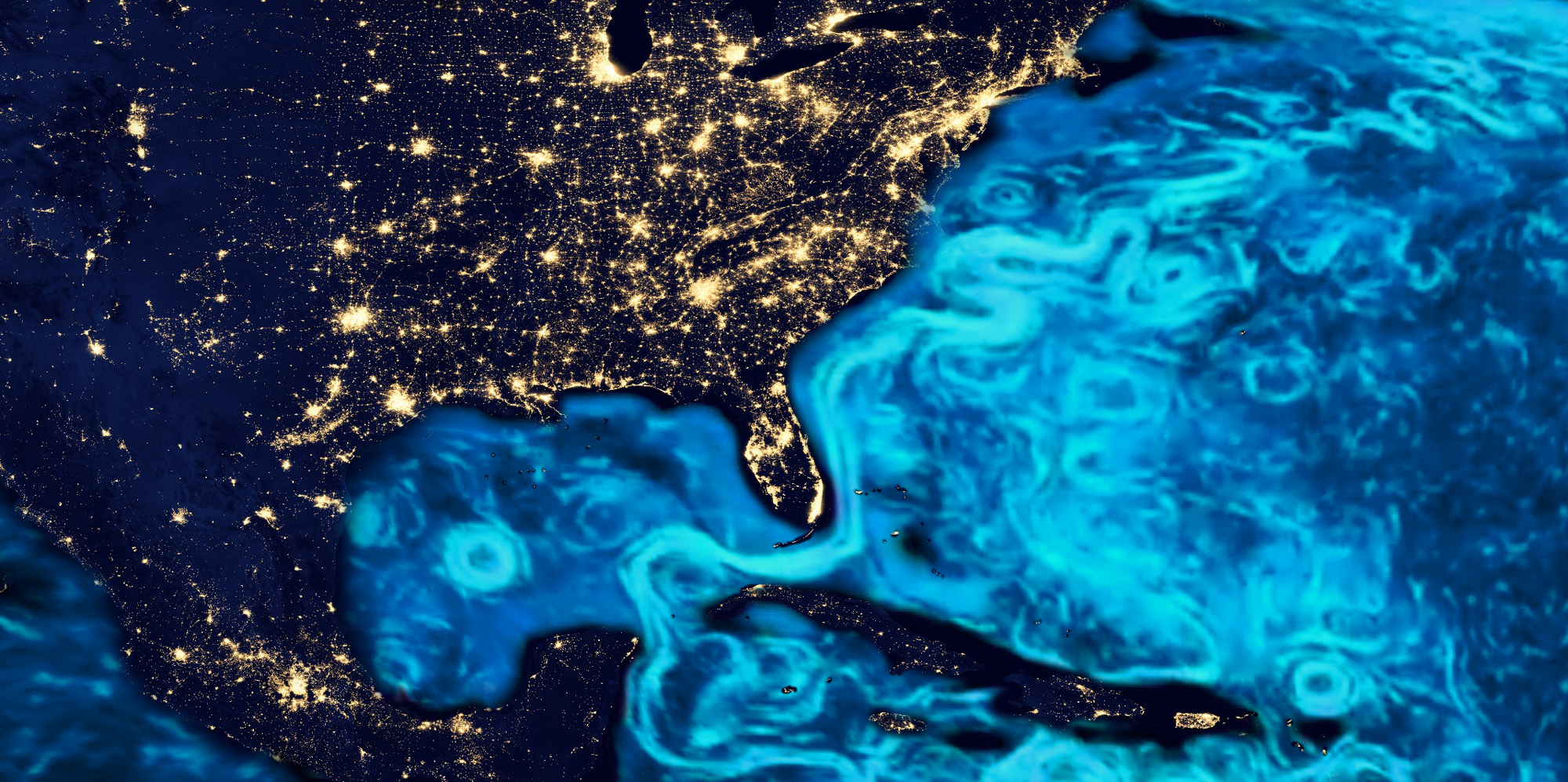
Andrey Solver, March 22, 2025.

From the Gulf of America, a powerful sea current flows past Florida. This is the beginning of the Gulf Stream, which crosses the Atlantic and releases accumulated heat, warming Europe. In addition to heat, this current has a gigantic kinetic energy. The Florida current carries about 32 million cubic meters of water per second, with an average speed of 1.8 meters per second, and in some areas, near Miami, 30 kilometers to the east, reaches 2.8 m/s.
It's a Big Energy. These are the 2,470 spillways of Hoover Dam.
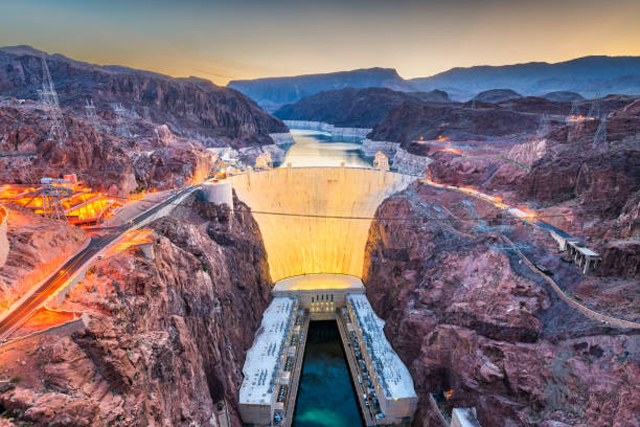
Is it possible to use this energy? Banal proposals to install underwater turbines encounter many engineering, environmental, financial, and other problems and limitations. The capital costs of building any traditional generators based on rotation will be very high, and the construction of any large infrastructure (dam) on the seabed is an unrealistic utopia.
The banal approach does not take into account the main property of this powerful sea river, which distinguishes it from all land rivers. This invisible trump card provides a huge advantage over all hydroelectric power stations in the world.
It's salt. Unlike fresh river water, seawater is a good conductor of electric current. Electricity can be obtained directly from water, without any moving parts in the generator. The only moving part, the linear rotor, is seawater itself.
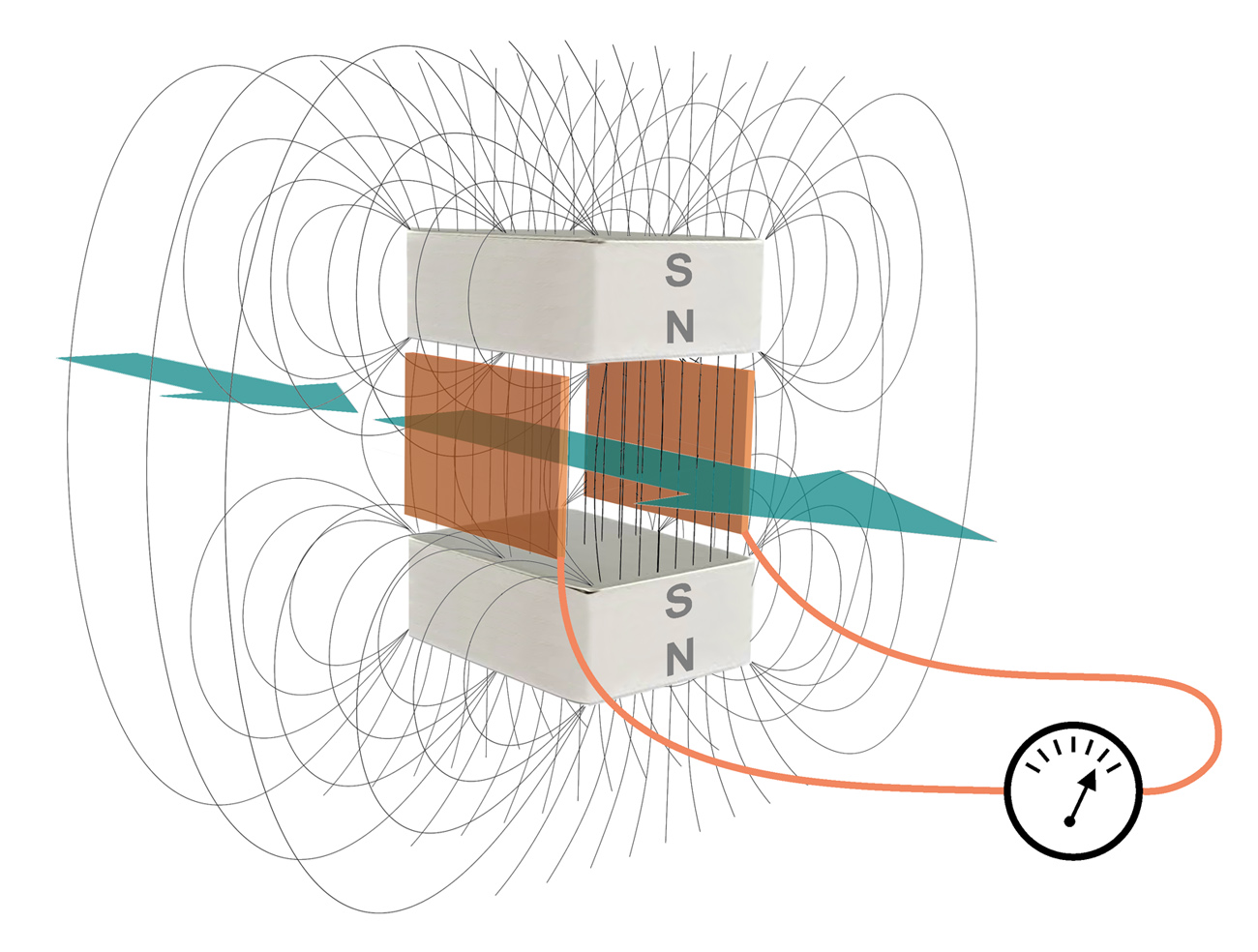
Since school days, we have known that the movement of a conductor in a magnetic field generates an electric current. Electromagnetic induction was discovered by Michael Faraday in 1831. He is the first and, very likely, the last person who tried to get electricity from moving natural water. In 1832, he and his assistants lowered copper sheets connected to a galvanometer from a bridge into the Thames.
From Faraday's law of Electromagnetic Induction followed that water flowing from west to east crosses the Earth's magnetic field lines, and it must generate electricity. However, despite the already rather high sensitivity of the galvanometers of that time (Ampere, Gauss and other scientists were already using and constantly improving measuring instruments), it was not possible to detect the appearance of an electric current from the river. This does not mean that it does not exist, but that this electric current is vanishingly small.
The maximum electric power can be calculated using the formula:
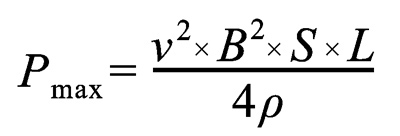
where
v – velocity of flow in meters per second, m/s,
B – magnetic B–field induction in tesla, T,
S – square of electrodes in square meters, m2,
L – length between electrodes in meters, m,
ρ – specific electrical resistance of water, in ohm × meter, Ω · m.
From this formula, it becomes clear why Faraday's experiment failed. Firstly, the induction of the Earth's magnetic field is very small B = 10–4 T and decreases even more when raised to a power of 10–8 T or 0.00000001 tesla. Such a small multiplier in the numerator destroys all other values. And secondly, the resistivity of fresh river water is quite high ρ = 100–200 Ω · m, and rainwater is very high ρ = 20,000 Ω · m, distilled water is considered a good insulator. Large numbers in the denominator of the fraction completely make it impossible to register such a small electrical power.
But the resistivity of salty seawater is much lower: ρ = 0.2 Ω · m, and the denominator becomes less than 1, increasing the overall value of the formula. At the same time, the use of a powerful magnetic field of permanent magnets makes it possible to obtain a significant electric current. Modern powerful neodymium magnets Nd2Fe14B have a high magnetic induction of B = 1.2 – 1.4 T, they are inexpensive and produced on an industrial scale. Also quite suitable more cheaper magnets Alnico, alloy of aluminum, nickel and cobalt with a B = 1.0 – 1.25 T.
![]()
Surprisingly, over the past 193 years after Faraday's research, science has moved far ahead: Magnetohydrodynamics has made it possible to create powerful industrial MHD generators operating on high-temperature plasma at thousands of degrees with supersonic speeds. Superconductors cooled by liquid gases are used to enhance the magnetic field, and MHD pumps pump molten metals in nuclear reactors... However, for almost two centuries, no one has proposed a working technology for directly generating electricity from moving water.
With the exception of general discussions about such a possibility and a fantasy novel in which Faraday's idea was relocated to the ocean with a ridiculous proposal to make contacts with a size of 1 km2 (!) and a distance between them of 100 m. I will not discuss the scale of the author's thoughts here, I will only calculate according to the formula: such a giant structure could produce a maximum power Pmax = 1 watt.
Despite the well-known suitability of salt electrolytes for MHD electricity generation, the main device developments have followed the energy-intensive path of plasma due to key parameters: low resistance ρ of the ionized medium and its high flow velocity v. Moreover, the square of the velocity makes this characteristic key: if high power is needed, then high velocity must be used. Therefore, everyone forgot about the slow flow of natural waters. After all, it is impossible to increase the velocity of the sea current... Or is it possible?
Let's turn to the origins of hydrodynamics, to the Benedetto Castelli ratio, and visualize the Venturi tube for clarity.

According to the law of conservation of mass and а continuity equation, all three colored volumes are equal, but the lengths L that water passes through at the same time are different. In the image, the water velocity v2 in the narrow part of the pipe is almost 9 times faster than in the wide parts v1 and v3.
The narrow and fast Florida current between the Gulf of America and the Atlantic can be considered as a large Venturi tube, and by recursively placing the same elements, velocity of the flow can be multiplied to very large values.
In the presented electric cell, the cross-sectional square of the chink is 5% of the total water intake square. So, the current velocity of 2 meters per second easily turns into 2/0.05 = 40 m/s. Everyone who has watered with a hose knows how the water velocity increases when the outlet is reduced. This, of course, is not supersonic (more than 331 m/s of air), but it is quite a sufficient velocity for the MHD generation of electricity.
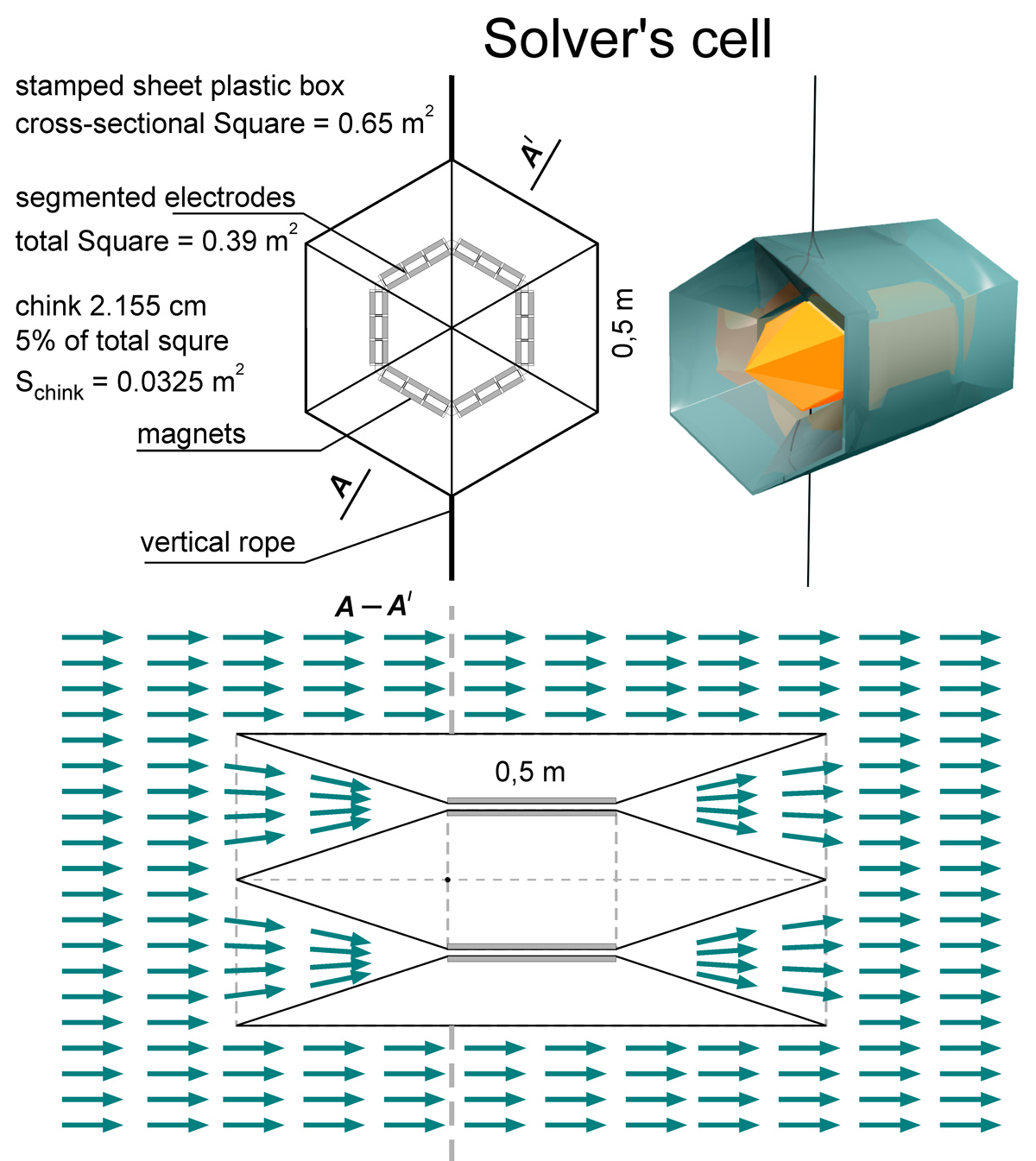
The cell is a box-shaped windvane 0.86×1×1.86 m, fixed on a vertical rope. A stream of seawater passes through a narrowing annular chink in which neodymium magnets and stainless steel electrodes are located. In mass production, its cost will be $10-20 .
Hanging in the seawater stream, this cell will generate electrical power:
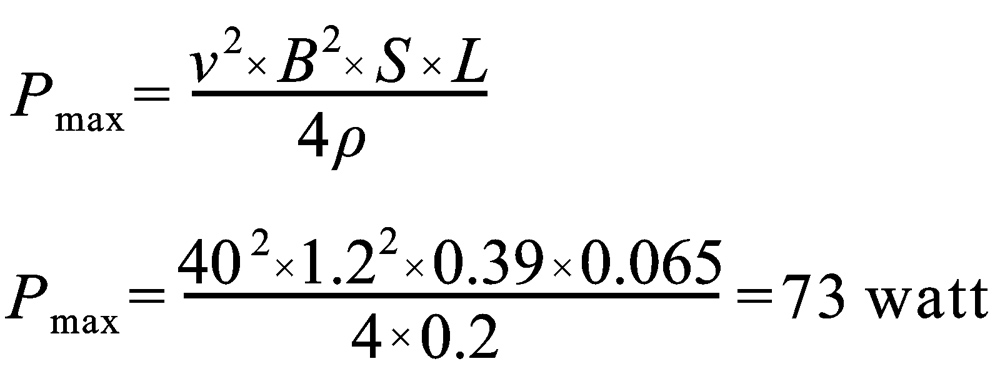
Also find the voltage:

and the current intensity:

In a simplest version, a garland of cells is located on a vertical rope between a weight and a float. But for mass installation, instead of heavy material-intensive concrete blocks, it is more cost-effective to drill the bottom and fix the anchor inside the well.
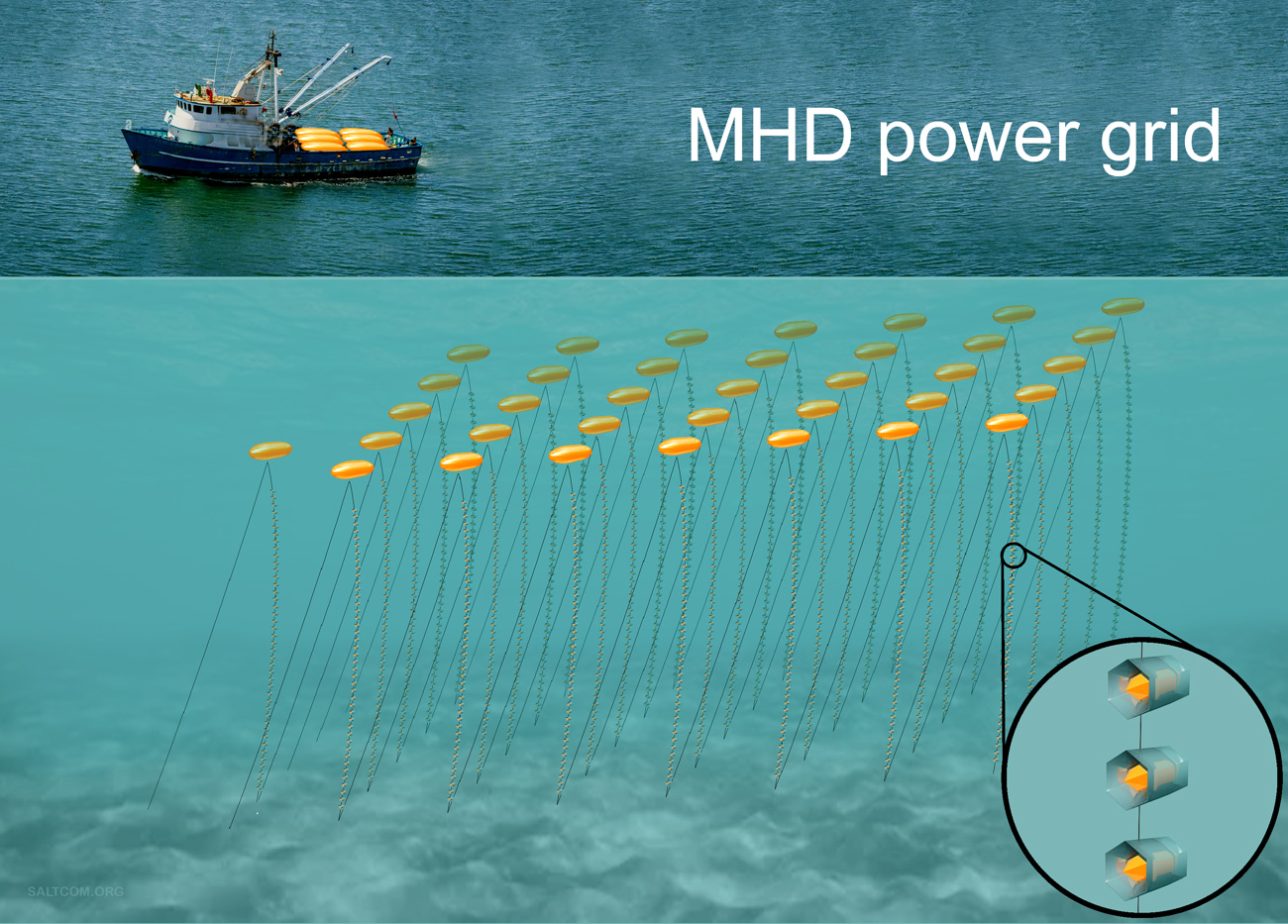
In the deep-sea parts of the Strait of Florida, up to a thousand cells can be placed on a single rope, and then this is a significant permanent generation of 73 kW, and a small "grove" is already megawatts of renewable electricity.
This technology is very environmentally friendly: there are no moving parts, no noise of any harmful effects on the environment, no animal or floating vehicle can get entangled in the net, because the distance between the ropes and between the floats and the surface is 20 meters.
If the cell is clogged with some foreign objects, fish, algae, or something else, then the property of the reversibility can be used. Instead of a load, an electric current can be applied to the electrodes, and the MHD generator will become the MHD pump. Since the electric current value is unlimited, a reverse pulse of 2-3 times the nominal value can produce a jet with a velocity of more than 100 m/s. The cell will "spit out" any object, rotate around the vertical axis, and return to its working position. A practical solution may be a solid-state relay that triggers when the generated current decreases. The automatic self-cleaning process can also be configured systematically: velocity, direction, time or frequency of the water jet can be pre-programmed or controlled in real time.
This technology can be easily scaled to very large capacities. The underwater "electric forest" the size of Miami can provide electricity 24/7/365 not only to this megapolis, but to the entire state of Florida (total capacity ~ 69 GW).
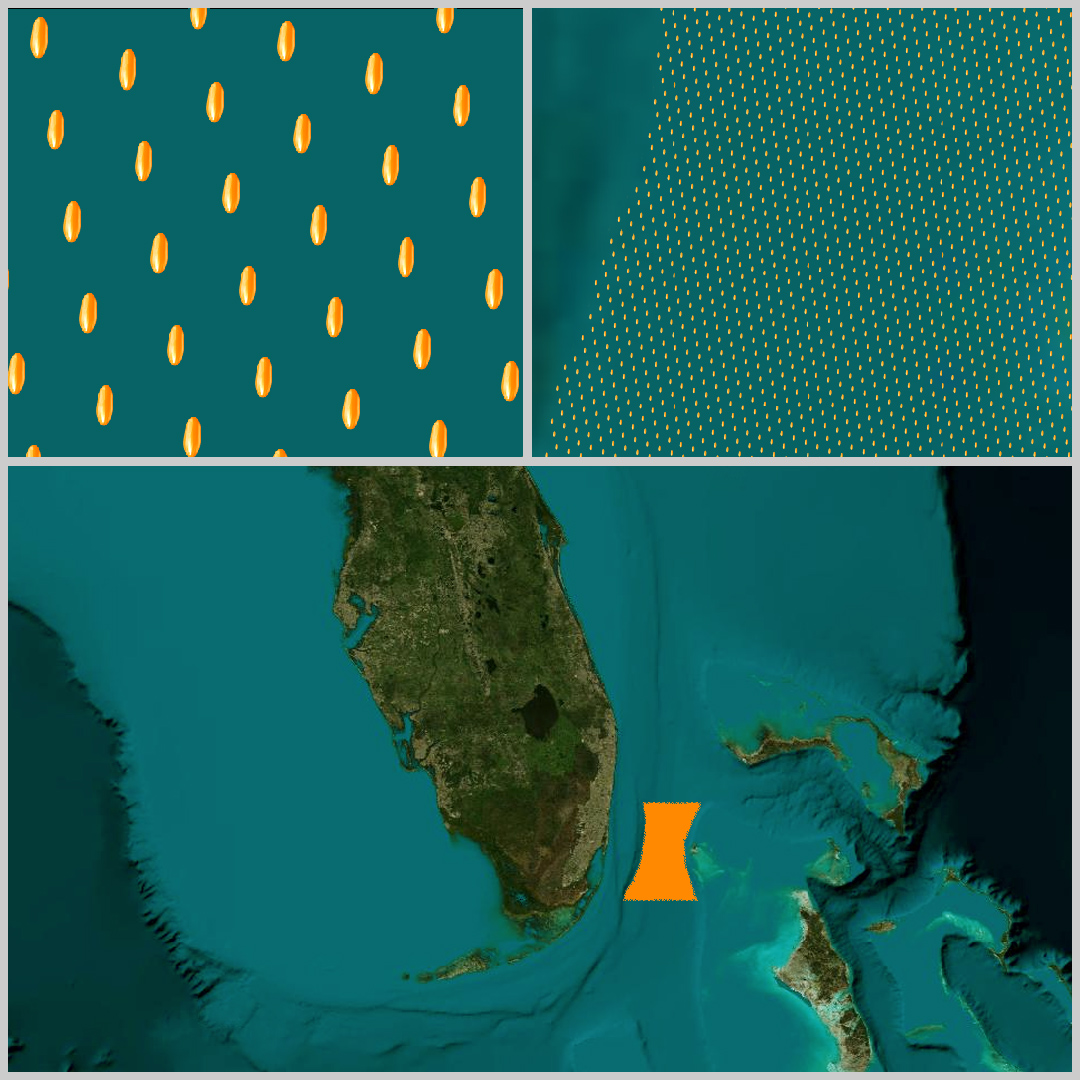
It should not be thought that only Florida and the East Coast are lucky enough to have a fast sea current. The Gulf Stream is only a part of the Global Ocean Conveyor Вelt, a closed system of ocean currents, among which there are both faster and more powerful in terms of water volume. For example, the speed of the Kuroshio Current off the coast of Taiwan and in the East China Sea is 1.5 – 2 m/s, and off the coast of Japan it reaches a speed of 2.5 m/s.
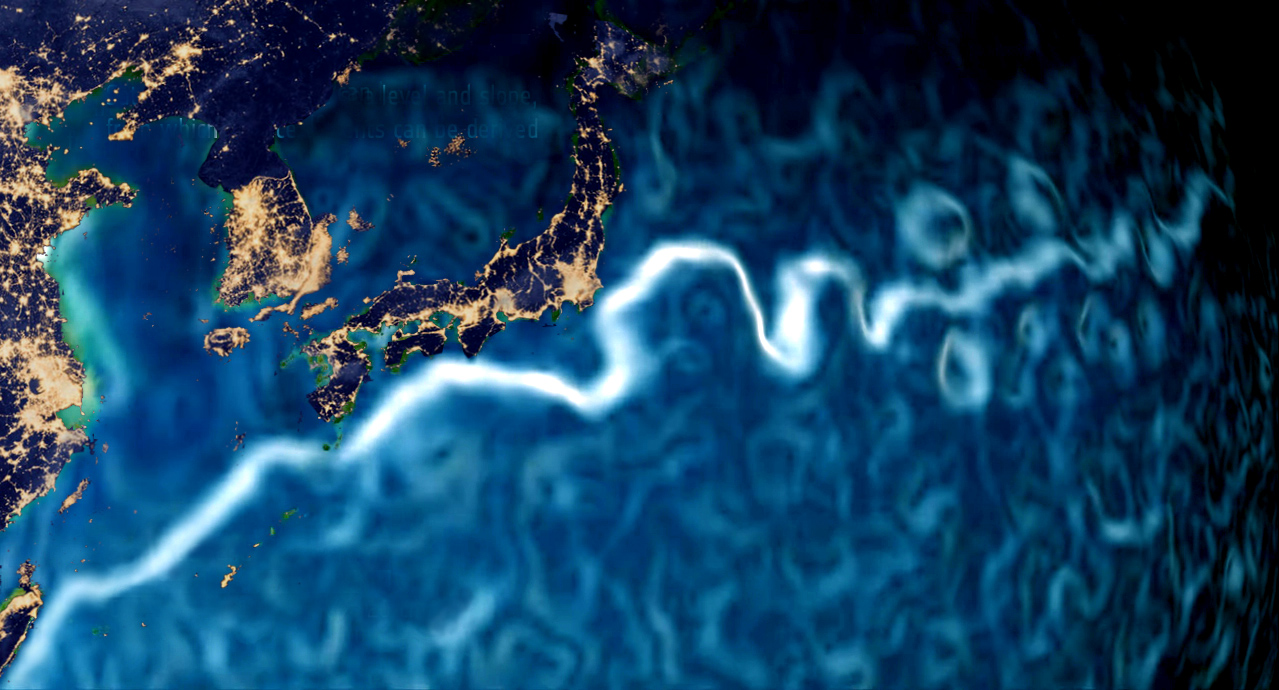
The top layer of water in the Strait of Gibraltar moves at a speed of about 2 m/s. It is also necessary to mention the most powerful current in the world, the Circumpolar Current, a giant motor rotating around Antarctica. In the Drake Passage between South America and Antarctica, its speed exceeds 4 m/s. The "electric forest" in this place could supply energy not even to a city or a country, but to an entire continent.
Video: Major Global Ocean Currents. Copernicus Marine Service.
The development of this technology will lead to the use of many other currents, and ultimately almost any movement of seawater, even in remote areas of the ocean (Equatorial Currents). There are already startups offering to transport electricity on battery ships, similar to how tankers transport oil now.
In addition, the War of the currents AC/DC is not finished yet: DC is winning, but not direct current, but Digital electricity. The ultra-small increment in generation will produce a "creeping revolution" in the electric power industry. I think that in the future, the largest share of the world's electricity will be generated in the ocean.
The world is entering the era of total electrification: AI, data centers, cryptocurrencies, robots, electric transport and manufacturing require more and more electric energy. However, generation has not kept up with progress, especially renewable energy. The resources of hydroenegetics in developed countries are almost exhausted, the introduction of new nuclear power plants is a long process, the sun and wind are unstable, expensive and not applicable everywhere (please see how we can cancel hurricanes). Therefore, underwater MHD generation, in addition to stability, independence from the caprices of the weather, eco-friendly, flexibility, safety, absence of fuel and high maintenance costs, has a very big advantage – it is cheap. A rope with electric cells costs much less than the construction of large facilities, dams and stations.
Specific capital investments in electric generation, USD / kW.
Coal stations |
1200-1400 |
Oil stations |
1000-1300 |
Natural gas |
1200-1500 |
Nuclear energy |
1800-2500 |
Hydro energy |
> 2000 |
Wind energy |
> 1800 |
Solar energy |
> 2500 |
Ocean MHD energy |
< 300 |
We call on all progressive people to support us and participate in the development of this technology. The ocean is an endless source of energy, the foundation of future abundance.
Video: The construction of the Hoover Dam on the Colorado River in 1931-1936, during the Great Depression. This project was the beginning of overcoming the economic crisis.
Music: "Time, forward!" Georgy Sviridov, National Orchestra of the Bolshoi Theatre, Moscow.